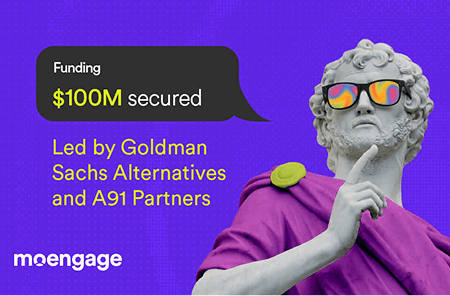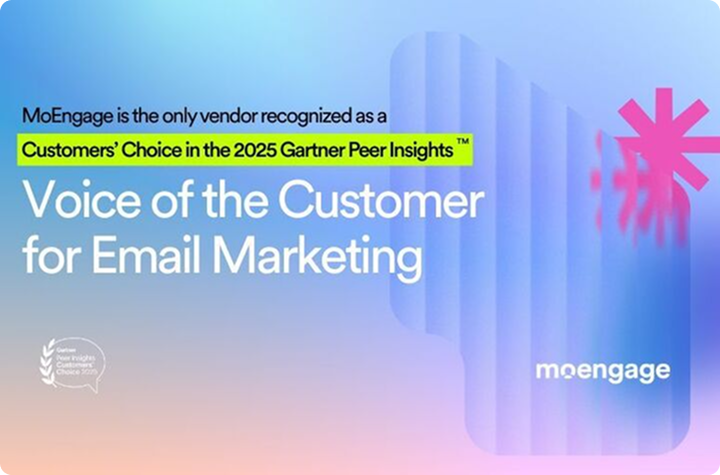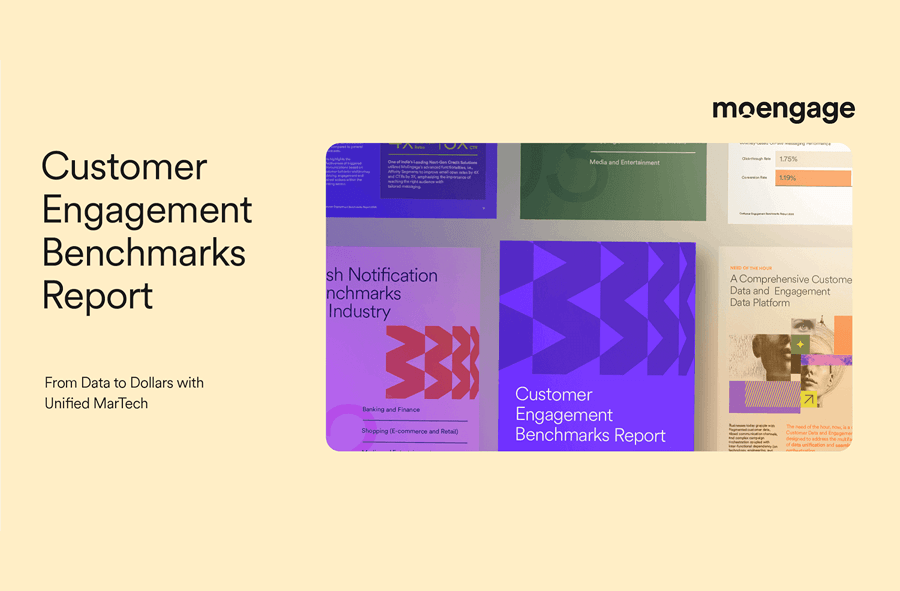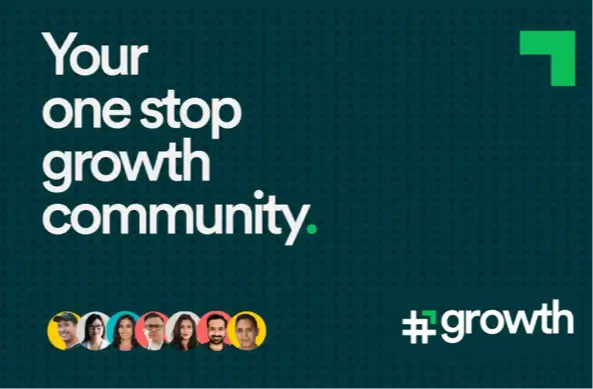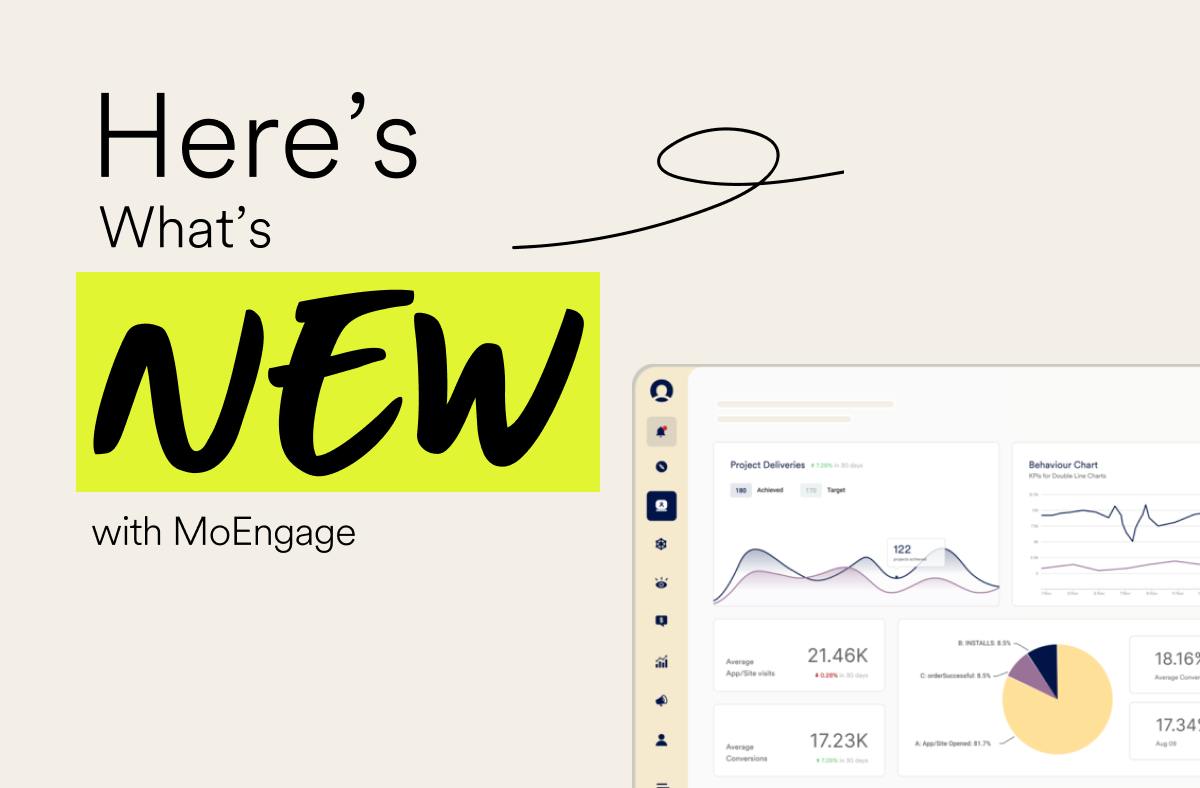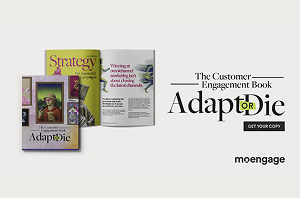Jennifer Finn Q&A: Customer Engagement Book Interview
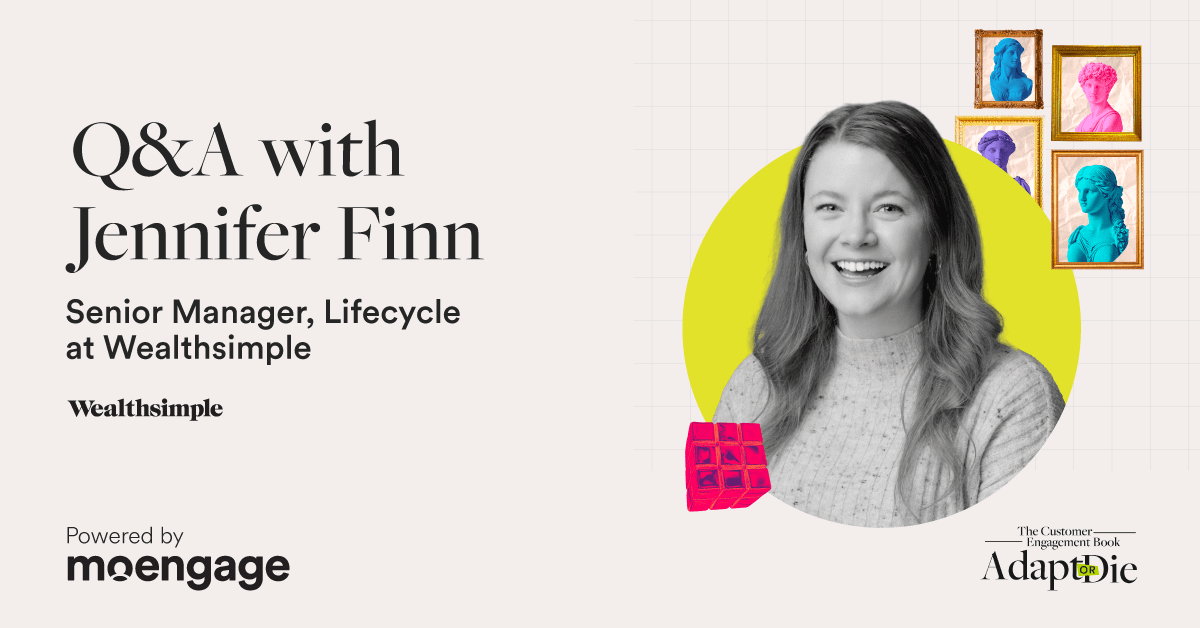
Reading Time: 10 minutes
Businesses must meet customers where they are across multiple channels to be successful.
That’s why, for Chapter 5 of our “Customer Engagement Book: Adapt or Die,” focusing on omnichannel strategy, we sat down with Jennifer Finn, Senior Manager, Lifecycle at Wealthsimple.
In this insightful Q&A, Jen shares invaluable lessons from a successful Bitcoin giveaway campaign.
She delves into how Wealthsimple leveraged various channels, including email, push notifications, and in-app surfaces, to drive both top-of-funnel and bottom-of-funnel engagement.
Get ready to learn about the critical role of customer data, how to adapt strategies mid-campaign, and why being part of the conversation in a trending market is essential.
Jennifer Finn Q&A Interview
1. Can you share a specific omnichannel campaign that you’ve executed that you consider to be particularly successful?
All of our campaigns these days are more often omnichannel.
In order to get the most reach and ultimately drive more results, Wealthsimple needs to meet our clients where they are, which is ultimately across different channels when you’re trying to serve Canadians across the board, regardless of their net worth, age, demographic, etc.
We know based on email preferences alone, if we chose to do a single email channel-only campaign, we could be losing 10% of our base right off the top, and then filtering down from there based on open rates. So it’s really limiting.
In more recent campaigns, we’ve been leveraging our in-app surfaces as a way to unlock new channels and extend reach.
In this particular example, I’ll dig into a Bitcoin giveaway that we chose to run. We know based on our segments we have cohorts that are more interested in crypto and cohorts that are not so interested, or not “crypto-curious,” as I’ll call them. In order to maximize our reach and personalize the experience to be more passive for those that tend to be less engaged, we employ different omnichannel tactics.
The campaign leveraged owned channels: email, push, multiple combinations of in-app surfaces paired with social and user acquisition efforts to drive top-of-funnel engagement in addition to bottom-of-funnel engagement like referrals with our current base of clients.
2. What was the overarching goal of this campaign, and how did it align with your broader business objectives?
The overarching goal was to be a part of the momentum crypto was experiencing and acquire new crypto clients and referrals.
One of the strengths we have at Wealthsimple: We’re able to be really scrappy.
This campaign is helping us understand how we might continue to move the needle into 2025, and how each of our products can play a part in helping us achieve broader company goals.
Campaigns like this move the needle in a big way but also help inform ways that we can continue to iterate and improve year over year.
3. How did you come up with the idea for this campaign and what kinds of trends influenced this approach?
It stemmed from having awareness on what was happening in the markets. Bitcoin in particular was projected to surpass its all-time high. There was a lot of noise.
What ultimately influenced and helped us build toward what we ended up launching was that we know crypto sees a lot of seasonality and is also cyclical with very long cycles.
That combined with the organic spikes we were seeing across the product motivated us to incentivize the referrals to double that growth.
At a very high level, it was great minds coming together, talking about what we were seeing in the market, talking about what we were seeing internally with the product, and having strong decision-makers in the room that said, “Let’s go for it.”
We’re still a very flat organization, but we’ve grown quickly and we’ve attracted some incredible experts in their own fields and functions.
Everybody comes together with industry and functional experience.
There’s a lot of passion and knowledge in the room when we start to see opportunities like this build: folks across lifecycle and growth, but also folks across our product and our legal and regulatory teams that can help us make decisions and move quickly in the right direction.
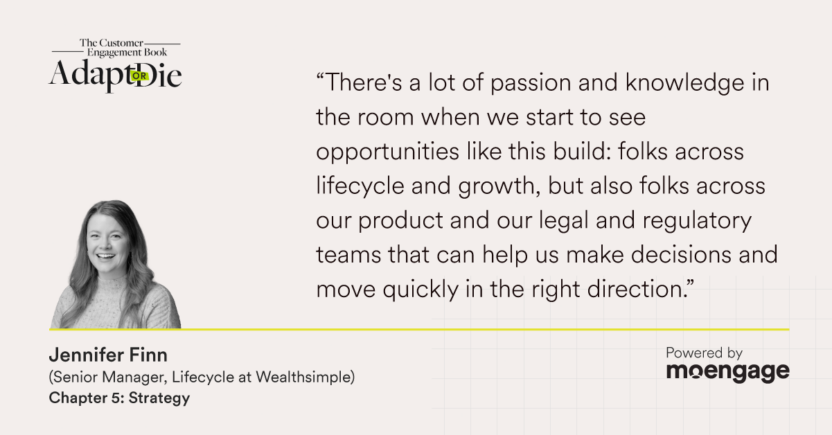
4. What role did customer engagement data play in shaping your strategy?
We have a solid base of clients.
Whether it’s via age, net worth, or assets under management, we’ve been able to identify cohorts of clients that tend to respond positively, at least at first, to our messaging surrounding crypto.
That customer engagement data allows us to be thoughtful with the channel and messaging combinations that we choose to send.
We also took information from previous experiments where we knew our crypto enthusiasts responded to particular messaging more than other clients, leveraging that to inform what channels have previously worked for us to help build that playbook when speaking to that particular segment of clients.
5. How did you decide which channels to include?
It’s really about leveraging previous experimentation and different channel combinations that we’ve used in the past, while not being afraid to outline any new channel combinations, given we’re constantly iterating and improving on those channels.
In this case, we have various surfaces within our app that we’ve been unlocking through our tooling over the past year.
One experiment might be seeing how much incremental new referrals or account openings we could drive via a new surface and comparing it to an old surface or a previously used surface.
A surface is just a new placement where we can start building marketing messaging and where marketing has the freedom or ownership to use it for various messaging.
One example might be targeting folks that we tend to see are less engaged and interested in crypto messaging and seeing how they might engage with a new channel like our notification center in the app, and comparing that to a global holdout for the campaign to see if that channel can drive incremental account opening.
6. What were the key steps required to execute this campaign successfully?
Crowdsourcing the idea has proven to be one of the best ways to build great products, ship effective product improvements, and run some of the most successful experiments and incentives we think in the industry.
What was great about this one is things really came together asynchronously.
It was a great way to leverage tooling that we use in-house like Slack to speed up the conversation and drill right down to the next steps and commit.
Being able to move quickly and ship something that we think is 90% good enough tends to help us move faster and steer the decision.
Perfection isn’t always attainable, whether it’s differences of opinions steering messaging and tactical execution. Finding a way to come together and find that direction ultimately helped us move forward.
Once in market, there’s a constant view on performance updates and even tweaks to optimize further. This is where we might see that an experiment is performing poorly.
We might have to quickly pivot or shift, or even just make slight channel updates based on client feedback.
7. Which specific teams and stakeholders did you have to collaborate with, and how did you ensure alignment across the functions?
It truly is a team effort across marketing and also product – touching creative, copy, lifecycle, product marketing, user acquisition, brand, etc.
And then working with our product leads to make sure that we’re using and talking about the product accurately, legal, regulatory operations, finance to make sure that we can pay out when it comes time to end and wrap up the contest, and then our engineering teams supporting to make sure that they can handle the volume we’ll hopefully be driving.
In ensuring alignment, at Wealthsimple, there’s generally this expectation to debate and then ultimately commit.
It’s a process that allows for all perspectives really early on but results in really clear next steps.
Slack and a combination of asynchronous, in-person, and online meetings tend to be the quickest and most effective way to get everybody on the same page and ultimately build toward how it comes to life more quickly.
8. What tools, platforms, technologies were critical in delivering a seamless omnichannel experience?
We use tooling like Slack internally that allows for remote working and messaging.
As a remote-first company, it’s a big part of how we crowdsource ideas, debate and commit, and move forward. When you put everything in writing, it’s the most effective way to move things forward.
We leverage our Lifecycle CRM tool, which is the biggest support for launching an omnichannel cross-channel campaign like this one. It allows us to build and execute these omnichannel marketing campaigns fairly seamlessly in terms of ensuring that we have the right segmentation, we’re leveraging the right channel mix, and being able to do so in a way that’s fairly automated. Once things are built and launched, it allows for pretty seamless QA.
We have various data analytics tools that allow us to determine the right path for the experiment. Identifying those external and internal market moments definitely comes down to having really great data visualization for what’s going on within your organization and across a specific product like crypto.
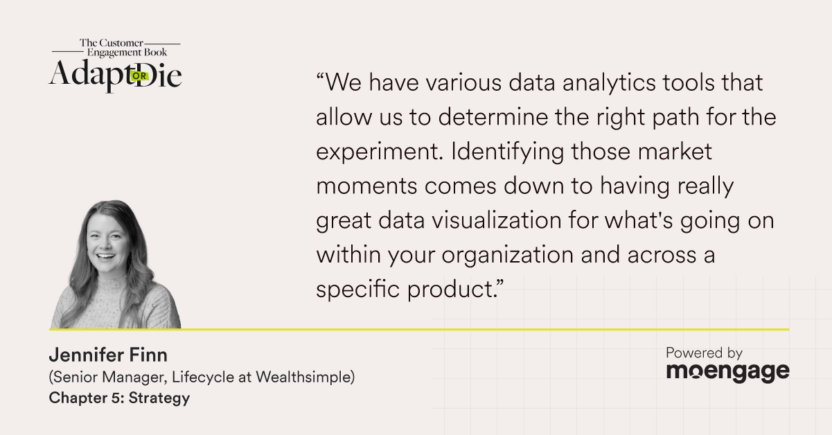
Then we leverage a number of platforms for both user acquisition and paid ads, as well as tooling to support social channels. Making sure that all these channels speak together and map into our data visualization tools allows us to look at channel success, channel performance, and ultimate campaign incrementality as well.
9. What were some of the biggest challenges you faced during the execution of this campaign, and how did you overcome them?
Time and having stakeholders and leads willing to chase down the right people and resources and then finding the capacity to bring it all together — time being the biggest challenge.
With a product in financial services, navigating legal and regulatory concerns or risk can also be time-consuming.
In this case, we have a bunch of incredible stakeholders and decision-makers that are willing to make those decisions really quickly to help steer us the right way from day one.
10. What were some unexpected obstacles or opportunities that emerged, and how did you address those?
Throughout 2024, we had been exploring and building out more in-app surfaces, trying to more effectively reach our clients where they are and when they’re engaging with the app, with the right messaging to have the most effect.
We always have to navigate challenges around having multiple app versions.
That’s a blocker and sometimes a speed bump for us, in terms of trying to make sure that as we continue to move quickly and build out these new surfaces, we’re thinking about our clients that are both on older app versions and newer app versions, and trying to build the most effective customer experience regardless can be really challenging.
Also, campaigns like this one, where folks can enter in a number of different ways — we were allowing folks to refer their friends, open new crypto accounts on our platform, but also enter via our social channels on Instagram and X — can be confusing in terms of giving different steps to follow to effectively enter and have their entrance counted toward the final draw.
We tend to drive a lot of client toil straight to our support team if this is done poorly.
Getting ahead and arming our social and support teams with the top FAQs always helps mitigate this.
But it was definitely a rocky start in terms of making sure that we’re really clear, at least on social channels, on what steps folks need to take in order to be counted.
11. What were some of the measurable results of this campaign, and how did it impact your overarching business goals?
Right off the bat, Lifecycle channels saw millions of impressions, which we know directly impacts the overall effectiveness of a big campaign like this one.
Giving away one whole Bitcoin at its high was the first time that we’ve done anything this big and noisy, at least with our crypto product. Millions of impressions across our in-app, email, and push channels was a really great way to make sure that we saw the reach that we needed for this campaign to be successful.
We know that number of impressions ladders right up to the frequency of the messaging that we’re hitting clients with. Within the three-week campaign, we quickly surpassed our goals for the campaign and ended the year off strong. So it was incredibly impactful in terms of driving the product growth that we were looking for.
Ultimately, this campaign drove a large portion of the total new product clients for 2024. It’s been really valuable for us to connect the dots to see what we need to do in 2025 to help meet overall product goals.
Something that is generally undervalued here too, because it’s not quantitative, is the general brand play.
At a time when the market is hot and competitors are making noise, ensuring that you’re part of that noise and part of the conversation when your clients and potential clients start thinking and talking about what actions they might make is really invaluable.
Being part of that narrative at a time when crypto was seeing this big market moment was key.
12. What advice would you give marketers in financial services who want to execute successful omnichannel campaigns?
Don’t be afraid to shift or pivot on a strategy mid-campaign if it’s not working for you.
Try to build for faster feedback loops. If you have KPIs and find that your results are soft partway through a campaign, being built so that you can shift or pivot mid-campaign is invaluable.
Run small experiments to start understanding your client base and how they react to different types of content channels.
Make sure that you’re set up to test, whether that’s as an A/B variant or against a control group. You need to use tooling that allows for quick experiment execution and analysis.
Define success at the beginning of an experiment or campaign to ensure that you understand what you’re left with at the end of the campaign.
Did you see what you were looking for? If you had to iterate and run the same thing over again, would you? Or did the campaign not perform as well as you had expected it to?
Ensure you’re set up with a global or campaign-level control to identify incremental messaging impact.
Having that global or campaign-level control set up from the beginning allows you to ensure that you’re looking at the right things and drilling down into the right results.
That would be rooted in ensuring that your campaign is set up from the start and that you’re getting the correct details throughout and after so that you can learn quickly.
I find that many companies, and we’re definitely at fault for it at Wealthsimple, move so quickly that if we’re not immediately reporting on results or learnings, they can often get left behind, and then we’ve never done a proper retrospective.
Document your channel conversion rates in one place so that you can start to identify content-level and channel-level conversion rates. This can help build a stronger growth model for larger campaigns, which ultimately ladder up to your quarterly, annual, or team goals.
Having it all in one place helps drive the story that you can share when you’re building the strategy for those campaigns in the future.
This interview Q&A was hosted with Jennifer Finn, Senior Manager, Lifecycle at Wealthsimple, for Chapter 5 of The Customer Engagement Book: Adapt or Die.
Download the PDF or request a physical copy of the book here.

